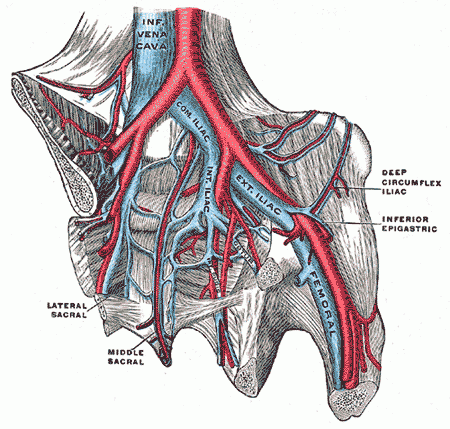

What is May-Thurner syndrome?
Also known as iliac vein compression syndrome, May Thurner syndrome (MTS) is a condition in which the left iliac vein in the pelvis becomes compressed by the overlying right iliac artery. The result of this is an increased risk of deep vein thrombosis (DVT) (i.e. blood clot) occurring in the left leg. Deep vein thrombosis can cause discomfort, but are not always serious. However, in some cases, it can lead to more serious complications, like venous insufficiency, and the potentially life-threatening pulmonary embolism.

What are the symptoms of May-Thurner syndrome?
May-Thurner syndrome is considered an anatomical variant – the right iliac artery is thought to at least partially compress the left iliac vein in a significant proportion of the population. However, most cases don’t cause problems unless the compression leads to the formation of a clot (deep vein thrombosis). The symptoms of DVT to watch out for are:
If the DVT causes venous insufficiency (when the veins struggle to return sufficient blood from the limbs to the heart, leading to a build-up of blood in the extremities), the following symptoms may result:
If part of the blood clot breaks off and travels to the lungs, this can cause a pulmonary embolism – a blockage of blood flow in the lungs, which can prove fatal, and is considered a medical emergency. You should immediately seek medical attention if you notice the following symptoms:
What is the treatment?
Some patients go through their lives without any complications of May-Thurner syndrome – many may not even know they have it. Even if they are aware of the condition, no treatment is necessary, unless it starts to produce symptoms.
Blood thinners may be prescribed to deal with blood clots. If these don’t work, are not recommended for the patient, or are unavailable, there are other medications designed to break down clots that can be introduced into the vein via a catheter.
There are also vena cava filters, which are inserted in the vena cava (the body’s largest vein) using a catheter, which will filter the blood travelling to the lungs, catching clots and preventing pulmonary embolisms.
In some cases, the doctor will recommend minimally-invasive surgery, for example a balloon angioplasty. In this procedure, a catheter with a balloon on the tip is inserted into the vein. The balloon expands, opening up the vein, after which a stent (a small mesh tube) is placed to hold the vein open once the catheter is removed, allowing normal blood flow.
Other surgical options include bypassing the blood around the blocked part of the vein, or repositioning the overlying artery
